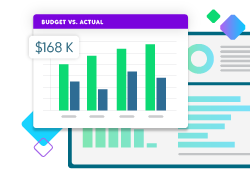7 Step Policy Guide for Creating Operating Reserves

Operating reserve funds used to be a tricky concept for many nonprofit organizations. But many nonprofits are becoming more comfortable about asking for support while also being financially secure enough to have an operating reserve. It is becoming more broadly understood that the cushion these reserves provide can sustain operations when there is an unexpected demand or dip in donations. Yet it is still imperative to state your intentions and make your case for operating reserves.
The key is to communicate clearly with all your stakeholders about the purpose of the operating reserves. With an understandable and accessible operating reserves policy, your team, Board, and donors know the specific reasons you would use your operating reserves and the exact amount that needs to always be in the fund.
7 Steps for Developing a Policy to Manage Operating Reserves
When establishing your nonprofit’s operating reserve policy, a key best practice is to have clear among your leadership and staff to ensure that all parties and the parameters for using it. Involving different points of view in drafting the policy will improve the process of implementing and managing the reserve.
- Inception: Make the case to your Board as to why your organization needs an operating reserve. Perhaps you’ve had some close calls in the past where a donation came in at the last minute, keeping a crucial program alive. Or maybe you’ve seen your peers struggle to manage a sharp increase in demand and want to get ahead of a similar situation in your nonprofit. Maybe you predictably run out of cash in March every year. Communicate to the board the value of an operating reserve and how it can help your organization better manage their resources in the long term.
- Recognition of Need: Once you get your Board to agree with the need for an operating reserve, they should assign the task of creating a policy to the finance committee. It might be helpful to include members of the finance staff who can provide reports on historical income and expenses. The Board may also set timelines for the policy development.
- Development: The designated members of the finance committee and staff should review other policy examples, references, and tools for establishing an operating reserve and determining the reserve ratio that makes sense for your organization. The members will consider the income volatility and spending flexibility specific to your organization. The Nonprofit Operating Reserves Initiative (NORI) created a toolkit with helpful information and sample language.
- Draft Policy: The Board-appointed team then presents the draft policy to the Board. The policy will include clear guidelines and protocols on how the fund should be managed, what the fund can be used for, and how the fund is replenished if funds are used. A section of the policy will also cover how to monitor and report on the fund’s status.
- Board Feedback: The Board should set aside time during a meeting to review the policy and ask questions of the members who created the draft. The Board can approve the policy or request that the team make updates based on the discussion. If changes are needed, the Board should decide if they need to meet again to discuss it or if members can approve the policy via email.
- Final Draft: Once the Board has approved the policy, it should be formalized and made available to internal and external stakeholders, as appropriate. This can include staff members, major donors, and auditors.
- Implementation: Now that the policy is formalized, your financial team can put it into practice and establish your operating reserve fund.
What Your Nonprofit Operating Reserves Policy Should Include
While every nonprofit organization’s policy will be nuanced to their situation, here are a few elements that should be included in all policies.
- Statement of Purpose and Philosophy: Put into writing the reason why your board established the operating reserve fund and state what the overarching objectives for the fund are. Don’t be afraid to be general here. You will get into the specifics of using and managing the fund later.
- Historical Information about the Fund: By including the history of why and when the fund was created, you give valuable background to Board members and staff who were not present at the time that the fund was established. This will also break down siloed information and prevent important knowledge from leaving with key employees.
- Definitions: Provide definitions of key terms that are going to be used in the policy to ensure common understanding. This includes standard accounting terminology, such as “net assets” and “restrictions,” for those who don’t have a nonprofit finance background, as well as definitions that will apply specifically to your organization, such as how you define financial stability.
- Use and Replenishment of the Fund: Be clear about protocols for the use and replenishment of the fund before the need arises. This will help things go much more smoothly when the time comes. Prepare forms that ask for pertinent information and authorizations. Also make sure to articulate how much can be drawn down, who is allowed to do this, for what reasons, and timing requirements for replenishing the funds. Outline how this will be documented and what the approval process will be. Thinking through the workflow and putting the details on paper in advance will help everyone follow appropriate steps when the time comes to use the fund.
- Managing and Monitoring the Fund: The policy will need to be clear about reporting on the status of the fund, and what happens to any income it may earn. Some boards allow a portion of the operating reserve funds to be invested but only in low-risk, near-liquid vehicles so funds can be accessed quickly without a penalty. Some groups have a separate investment policy that provides guidelines for liquidity and risk thresholds for various categories of funds. But if there is no separate investment policy, it’s a good idea to mention the risk threshold for your operating reserves within the policy itself, even if it’s only a couple of sentences.
- Role of the Finance Committee: Describe the responsibilities of the Finance Committee with regard to the operating reserve and other board-designated funds oversight. Document how often the committee will review and update the policy, recommend additional designations, and the information they need to report to the larger Board.
Internal Controls Through Your Operating Reserves Policy
Your nonprofit operating reserve fund gives your organization a financial cushion and the breathing room to make more strategic, long-term decisions. To avoid questions about why it is there and how it should be used, like all your internal controls, your operating reserves policy should be well-documented, easily accessible, and reviewed on a regular basis. Your policy, and your larger internal controls, will help you build trust with your donors that you are stewarding their contributions wisely.
To learn more about operating reserves, check out our Nonprofit Operating Reserves Toolkit.
Fund Accounting Software that Drives Impact
Find out how Blackbaud’s Financial Edge NXT® fits your organization.

This post was originally published October 2016 and updated September 2022.



